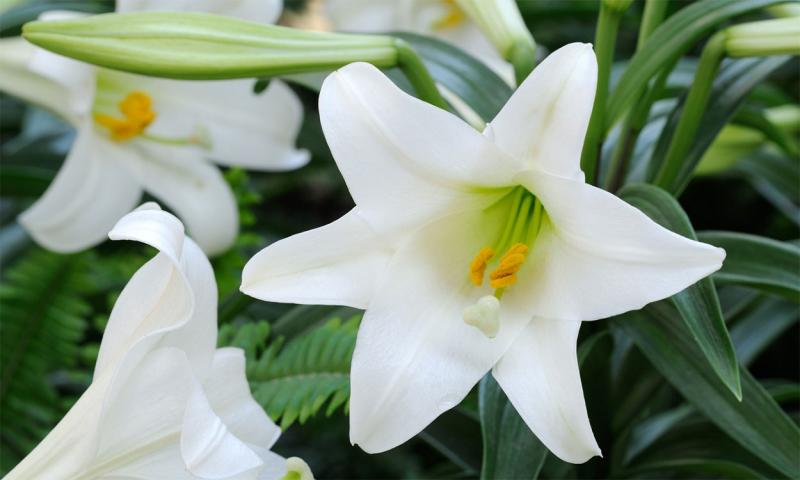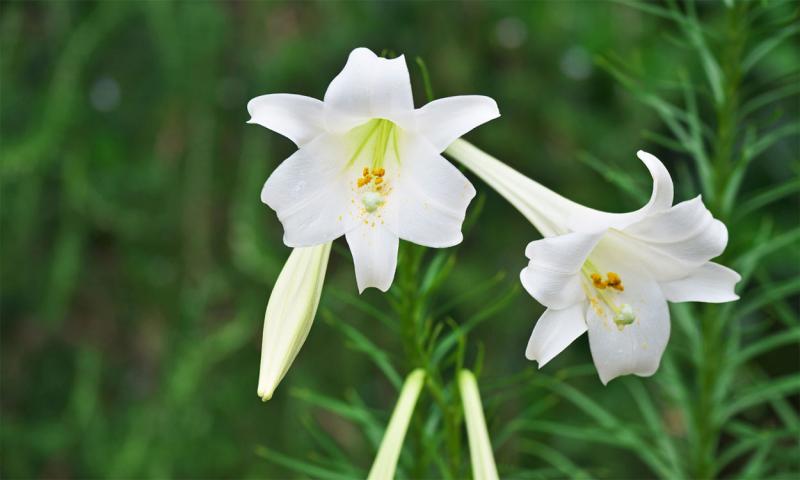
Written by Cindy Schnabel, South Dakota State University (SDSU) Extension Horticulture Assistant and Master Gardener, under the direction and review of Kristine Lang.
The Easter lily (Lilium longiflorum) is a long, white, trumpet-shaped flower with a sweet fragrance seen at grocery stores, flower shops, greenhouse and big-box stores. It is the fourth-largest potted plant crop grown in the United States. Easter lilies have long been associated with spring, purity and resurrection. Easter lilies originated in Japan, but now 95% of Easter lilies come from an area along the border of California and Oregon. Below are some care instructions to ensure enjoyment of your Easter lily throughout the spring.
Plant Selection
When purchasing Easter lilies, you should select a compact plant with dark-green leaves. It is preferable to have one or two open flowers and several unopened, bright-green, buds of different sizes. This will give you continuous blooms for two to three weeks in the proper environment. Caution: Easter lilies are toxic to cats if any part of the plant is consumed, but there is no known harm to dogs.
Plant Care
Light and Temperature
Easter lilies need a cool, bright spot within the home, but keeping the plants out of all-day direct sunlight can prolong bloom time. The recommended daytime temperatures are 65 to 70 degrees Fahrenheit and slightly cooler for nighttime. Easter lilies are sensitive to cold drafts.
Flowers
As the flowers open, remove the yellow anthers. This will prolong the life of the flowers, eliminate pollen shed and prevent the pollen from staining the white leaves, tablecloths and your clothing. Remove the flowers as they wither to improve the aesthetic of the plant and conserve energy for additional buds.
Watering
Water the lily when the surface of the soil is dry to the touch. Water until the soil is thoroughly moist. You can tell when this happens because water will flow from the drainage holes of the pot. Proper watering will prolong the flowers.
Typically, Easter lilies are sold with pots wrapped in pretty spring-colored foil. Either poke holes in the bottom of the foil and place a saucer underneath, or remove the decorative foil when watering. If water collects inside the foil liner, it can waterlog the plant and cause roots to rot or deteriorate.
Keep or throw away?

When the lily has stopped blooming, you need to decide whether to keep the plant or throw it out. An Easter lily grows from a bulb and can be grown as a perennial in South Dakota. If you decide to keep it, continue to care for the plant until it begins to yellow and die back. When all danger of frost is gone, find an outside location that is protected, has full sun and good drainage. Cut any remaining stalk off, remove the bulb from the pot and plant the bulb six inches deep in the soil. You may see some new growth emerge in the summer after planting, but look for new blooms the following June.
References and Resources
- Graper, D. 2019. SDSU Extension. It’s Easter Lily Time!
- N.A. 2018. UNR Extension. The History and Tradition of the Easter Lily.
Special thanks to SDSU Extension Master Gardener Tim Schreiner for serving as volunteer copyeditor of this article.


